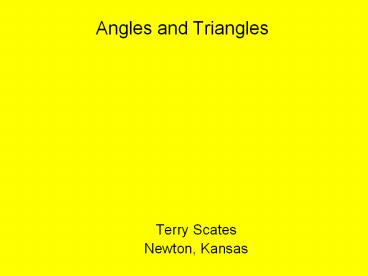Angles and Triangles PowerPoint PPT Presentation
Title: Angles and Triangles
1
Angles and Triangles
- Terry Scates
- Newton, Kansas
2
Instructor Notes
- Subject Area(s) Math
- Grade level 7th grade
- Lesson Length 50 minute class period
- Synopsis Name triangles by angles and sides.
- Objective/goals Students will classify
triangles according to types or angles and sides.
- (This PowerPoint presentation was designed as a
supplemental piece to the presentation entitled
Classifying Triangles by James Wiens for students
in the special education math class.)
3
Instructor Notes
- Standard ? identifies angle and side properties
of triangles and quadrilaterals (KS standard
7.3.1.k3) - Pre-requisite skills Vocabulary Acute,
Obtuse, Right, Equilateral, Isosceles, Scalene - TurningPoint functions standard question slides
- Materials All instructional points and practice
problems are provided within the power point
slides. Practice questions are designed to be
used with the TurningPoint clickers. - (This PowerPoint presentation was designed as a
supplemental piece to the presentation entitled
Classifying Triangles by James Wiens for students
in the special education math class.)
4
Lesson Outline
- 1. Warm-up Angle classification
- 2. Setting the Stage
- 3. Guided practice Turning Point Questions
- 4. Independent practice Paper pencil
- 5. Closure Write about triangles
5
What we already know about angles
- An angle has two sides that share a common
endpoint.
6
What we need to know about angles
- The point where the sides meet is called the
vertex.
7
What we need to know about angles
- Angles are measured in degrees, where 1 degree is
one of 360 equal parts of a circle.
8
Angles are classified according to their measure.
- An acute angle is less than 90
- An obtuse angle is more than 90
- A right angle is 90
9
Right Angle
- Find some examples of right angles in the
classroom
10
Acute Angle
- Find some examples of acute angles in the
classroom
11
Obtuse Angle
- Find some examples of obtuse angles in the
classroom
12
Classify this angle
Classify this angle
- Acute
- Right
- Obtuse
13
Classify this angle
- Acute
- Right
- Obtuse
14
Classify this angle
- Acute
- Right
- Obtuse
15
What we already know about triangles
- A triangle is a figure with three sides and three
angles. - The symbol for triangle is
16
What we need to know about triangles
- The sum of the measures of the angles of a
triangle is 180. - You can use this to find a missing angle measure
in a triangle.
17
Triangles can be classified by the measures of
their angles.
18
- An acute triangle has three acute angles.
19
- An obtuse triangle has one obtuse angle.
20
- A right triangle has one right angle.
21
Triangles can also be classified by the lengths
of their sides.
22
- Sides that are the same length are congruent
segments and are often marked by tick marks.
23
- In a scalene triangle, all sides have different
lengths.
24
- An isosceles triangle has at least two congruent
sides.
25
- An equilateral triangle has all three sides
congruent.
26
Classify this triangle by angles and by sides
7
70
4
40
70
7
- Acute / Isosceles
- Obtuse / Isosceles
- Acute / Scalene
- Obtuse / Scalene
27
Classify this triangle by angles and by sides
8
90
30
4
9
60
- Acute / Isosceles
- Right / Isosceles
- Acute / Scalene
- Right / Scalene
28
Classify this triangle by angles and by sides
14
130
6
15
35
18
- Acute / Isosceles
- Obtuse / Isosceles
- Acute / Scalene
- Obtuse / Scalene
29
Classify this triangle by angles and by sides
7
60
60
7
7
60
- Acute / Isosceles
- Right / Isosceles
- Acute / Equilateral
- Obtuse / Scalene
30
You are ready to try on your own!
- Think about what you have learned.
- Think about what you already knew.
- Think about what you can teach others.
31
Independent Practice
32
Independent Practice
33
Answer Key for Independent Practice
- Obtuse / Isosceles
- Acute / Equilateral
- Right / Isosceles
- Acute / Isosceles
- Obtuse / Isosceles
- Acute / Equilateral
- Obtuse / Scalene
- Right / Scalene
34
Closure/Summary
- Is the sum of the angles of an obtuse triangle
greater than the sum of the angles of an acute
triangle? Explain your answer.
35
References
- Glencoe McGraw-Hill Math Connects Course 2, Study
Guide and Intervention - and Practice Workbook, 2008.
- Wiens, James, Classifying Triangles, PowerPoint
presentation, November 2008.

